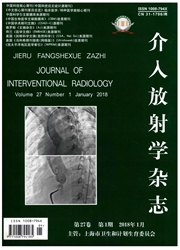

 中文摘要:
中文摘要:
目的 体外实验评价热损伤对肝细胞肝癌(HCC)细胞增殖、侵袭转移能力及上皮-间质细胞转化(EMT)等特性的影响,探索热消融与HCC复发转移之间的关系。方法 通过体外加热构建Mc ARH7777 HCC细胞热损伤模型。CCK-8法检测热损伤对HCC细胞增殖能力的影响,流式细胞技术检测细胞周期情况。Transwell实验研究热损伤对HCC细胞侵袭能力的影响。荧光定量-聚合酶链反应(RTPCR)和蛋白印迹(Western blot)分析热损伤对HCC细胞侵袭及EMT相关分子标志物VEGF、MMP-9、Nm23、E-cadherin、vimentin的m RNA和蛋白表达的影响。结果 Mc A-RH7777 HCC细胞热处理条件为43.5℃水浴30 min。热处理后2~5 d细胞增殖能力显著高于对照组(P〈0.05)。热处理48 h及72 h后处于G1期细胞比例降低,S+G2期细胞比例增加,差异有统计学意义(P〈0.05)。与对照组比较,热处理后24 h后HCC细胞侵袭能力差异不明显,而热处理72 h后细胞侵袭能力显著增加(22.3±2.46对14.2±1.82,P〈0.001)。RT-PCR和蛋白印迹分析结果显示,热处理72 h后HCC细胞VEGF、MMP-9和vimentin表达水平显著增加,E-cadherin表达显著降低,差异有统计学意义(P〈0.05)。结论 亚致死量热损伤诱导Mc ARH7777 HCC细胞发生EMT并增加其增殖和侵袭转移能力,表现出更高的恶性潜能。
 英文摘要:
英文摘要:
Objective To evaluate the influence of thermal damage on the cell proliferation, invasive metastasis and epithelial-mesenchymal transition of hepatoeellular carcinoma (HCC) through experiments in vitro, and to explore the relationship between thermal ablation and the recmTenee, metastasis of HCC. Methods The MeA-RH7777 HCC cell thermal damage model was established by using external heating method. The effect of thermal damage on the proliferation of HCC cells was detected by Kit-8 assay (CCK-8), and the cell cycle changes were studied by flow eytometry. The effect of thermal damage on the invasion potential of HCC cells was assessed by using Transwell assay. Fluorescence quantitative polymerase chain reaction (RT-PCR) and Western blot were used to evaluate the influence of thermal damage on HCC cell invasion potential, and on the mRNA and protein expression levels of EMT-related molecular markers, including VEGF, MMP-9, Nm23, E-eadherinand vimentin. Results Heating treatment of MeA-RH7777 HCC cells was pedbrmed by putting the cells in 43.5℃ water basin for 30 min. Two to five days after heating treatment the cell proliferative ability was significantly higher than that of control group (P〈0.05). At 48-72 hours after heating treatment the proportion of HCC cells in G1 phase was obviously reduced and the proportion of HCC cells in S+G2 phase was significantly increased, the differences were statistically significant (P〈0.05). Compared with the control group, the difference in HCC cell invasion potential determined at 24 h after heating treatment was not significant, while the HCC cell invasion potential determined at 72 h after heating treatment was strikingly increased (22.3±2.46 vs.14.2±1.82,P〈0.001). Real-time PCR and Western blotting results indicated that at 72 h after heating treatment the expression levels of VEGF, MMP-9 and vimentin were significantly increased, while the expression level of E- cadherin was remarkably decreased, the differences were statistically signific
 同期刊论文项目
同期刊论文项目
 同项目期刊论文
同项目期刊论文
 Increased metastatic potential of residual carcinoma after transarterial embolization in rat with Mc
Increased metastatic potential of residual carcinoma after transarterial embolization in rat with Mc 期刊信息
期刊信息
